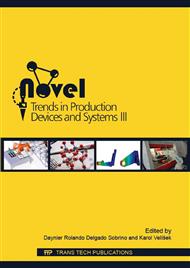[1]
A Barbacki, M Kawalec, A Hamrol: Turning and grinding as a source of microstructural changes in the surface layer of hardened steel. Journal of Materials Processing Technology. Vol. 133/1-2, 2003, pp.21-25.
DOI: 10.1016/s0924-0136(02)00211-x
Google Scholar
[2]
F Klocke, E Brinksmeier, K Weinert: Capability Profile of Hard Cutting and Grinding Process. Annals of the CIRP (2005), Vol. 54/1. pp.22-45.
DOI: 10.1016/s0007-8506(07)60018-3
Google Scholar
[3]
S.C. Veldhuis, G.K. Dosbaeva, A. Elfizy, G.S. Fox-Rabinovich, and T. Wagg: Investigations of White Layer Formation During Machining of Powder Metallurgical Ni-Based ME 16 uperalloy, JMEPEG (2010) 19: 1031–1036.
DOI: 10.1007/s11665-009-9567-7
Google Scholar
[4]
YB Guo, AW Warren, F Hashimoto: The basic relationships between residual stress, white layer, and fatigue life of hard turned and ground surfaces in rolling contact, CIRP Journal of manufacturing Science and Technology, 2010, Vol. 2/2, pp.129-134.
DOI: 10.1016/j.cirpj.2009.12.002
Google Scholar
[5]
S Akcan, S Shah, SP Moylan, PN Chabra, S Chandrasekar, TN Farris: Characteristics of white layers formed in steels by machining. ASME Med. Vol. 10. Manufacturing Science and Engineering, Nashville TN, 1999, pp.789-795.
DOI: 10.1115/imece1999-0742
Google Scholar
[6]
J Barry, G Byrne: TEM study on the surface white layer in two turned hardened steels. Materials Science and Engineering, Vol. 325/1, 2, 2002, pp.356-364.
DOI: 10.1016/s0921-5093(01)01447-2
Google Scholar
[7]
Yue Caixu, Liu Xianli, Ma Jing, Liu Zhaojing, Liu Fei, and Yang Yongheng, Hardening Effect on Machined Surface for Precise Hard Cutting Process with Consideration of Tool Wear. CHINESE JOURNAL OF MECHANICAL ENGINEERING, Vol. 27, No. 6, 2014. 1249-1255.
DOI: 10.3901/cjme.2014.0922.154
Google Scholar
[8]
Y. Kevin Chou, Cris J. Evans: White layers and thermal modelling of hard turned surfaces. Int. Journal of Machine Tools and Manufacture Vol. 39/12, 1999, pp.1863-1881.
DOI: 10.1016/s0890-6955(99)00036-x
Google Scholar
[9]
S.B. Hosseinia, T. Benob, U. Klementa, J. Kaminskia, K. Ryttberg: Cutting temperatures during hard turning—Measurements and effects on white layer formation in AISI 52100S.B. Journal of Materials Processing Technology 214 (2014) 1293–1300.
DOI: 10.1016/j.jmatprotec.2014.01.016
Google Scholar
[10]
E Brinksmeier, T Brockhoff: White Layers in Machining Steels, 2. Int. Conf. on High Speed Machining, PTW TV, Darmstadt, 1999, pp.7-13.
Google Scholar
[11]
D Brandt.: Randzonenbeeinflussung beim Hartdrehen, Dr. Ing. Dissertation, Institute for Production Engineering and Machine Tools, Universität Hannover, (1995).
Google Scholar
[12]
H Tönshoff, H Wobker, D Brandt: Eigenspannungen und Randzonenausbildungen beim Hartdrehen. HTM Härterei-Technische Mitteilungen, Band 50 (1995) Heft 3, pp.176-181.
Google Scholar
[13]
Ryutaro Tanaka, Hiroki Morishita, Yongchuan Lin, Akira Hosokawa, Takashi Ueda, and Tatsuaki Furumoto: Cutting Tool Edge Temperature in Finish Hard Turning of Case Hardened Steel, Key Engineering Materials Vols. 407-408 (2009) pp.538-541.
DOI: 10.4028/www.scientific.net/kem.407-408.538
Google Scholar
[14]
D. Umbrello, I.S. Jawahir: Numerical modeling of the influence of process parameters and workpiece hardness on white layer formation in AISI 52100 steel, Int. J. Adv. Manuf. Technol. (2009) 44: 955–968.
DOI: 10.1007/s00170-008-1911-9
Google Scholar
[15]
Chunzheng Duan, Weisen Kong, Qinglong Hao, Feng Zhou, Modeling of white layer thickness in high speed machining of hardened steel based on phase transformation mechanism. Int J Adv Manuf Technol (2013) 69: 59–70.
DOI: 10.1007/s00170-013-5005-y
Google Scholar
[16]
Fuzeng Wang, Jun Zhao, Anhai Li, Hongxia Zhang, Effects of cutting conditions on microhardness and microstructure in high-speed milling of H13 tool steel. Int J Adv Manuf Technol (2014) 73: 137–146.
DOI: 10.1007/s00170-014-5812-9
Google Scholar
[17]
Xufan Yan, Song Zhang, Chengliang Zhang, Gaoli Cai, Electrochemical characteristics of white layer generated by hard milling AISI H13 steel. Int J Adv Manuf Technol (2014) 75: 1799–1807.
DOI: 10.1007/s00170-014-6255-z
Google Scholar
[18]
J Rech, A Moison: Surface Integrity in Finish Hard Turning of Case Hardened Steels Application to Gear Cone Brakes. Proc. Of the Int. Conf. On Manufacturing Engineering (ICME) 3-4 Oct, 2002. Haikidiki, Greece. pp.195-203.
Google Scholar
[19]
G Poulachon, A Albert, M Schluraff, IS Jawahir: An experimental investigation of work material microstructure effects on white layer formation in PCBN hard turning, Int. Journal of Machine Tools and Manufacture, 2005, Vol. 45/2, pp.211-218.
DOI: 10.1016/j.ijmachtools.2004.07.009
Google Scholar
[20]
C. Cappellini, A. Attanasio, G. Rotella, D. Umbrello, Formation of white and dark layers in hard cutting: influence of tool wear, Int J Mater Form (2010) Vol. 3 Suppl 1: 455– 458.
DOI: 10.1007/s12289-010-0805-1
Google Scholar
[21]
B. Denkena, T. Grove, O. Maiss, Influence of the cutting edge radius on surface integrity in hard turning of roller bearing inner rings. Prod. Eng. Res. Devel. (2015) 9: 299–305.
DOI: 10.1007/s11740-015-0615-x
Google Scholar
[22]
J. Schmidt: Mechanische und Thermische Wirkungen beim Drehen Gehärteter Stähle. Dr. -Ing. Dissertation, Universität Hannover, (1999).
Google Scholar
[23]
DT Jeffrey, NM Shreyes, AP Roberta, RW Thomas: Effect of Cutting-Edge Geometry and Workpiece Hardness on Surface Residual Stresses in Finish Hard Turning of AISI 52100 Steel. Journal of Manufacturing Science and Engineering Vol. 122/4 2000, pp.642-649.
DOI: 10.1115/1.1286369
Google Scholar
[24]
J. Kundrák, Z. Gácsi, K. Gyáni, V. Bana and G. Tomolya: X-ray diffraction investigation of white layer development in hard-turned surfaces, The International Journal of Advanced Manufacturing Technology, 2011, DOI 10. 1007/s00170-011-3811-7.
DOI: 10.1007/s00170-011-3811-7
Google Scholar


